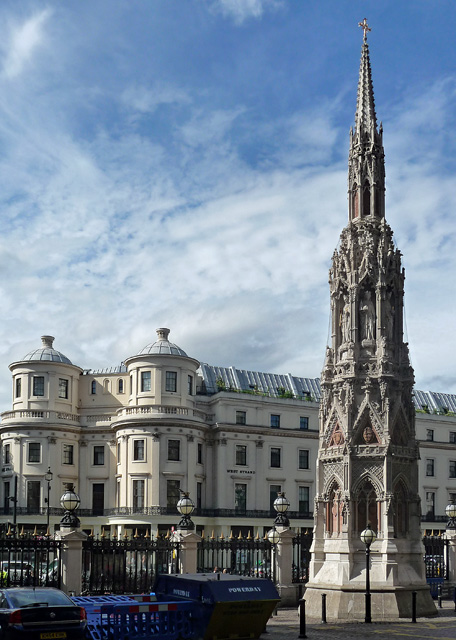In the course of writing my present book, a sequel to A Play of Deceit, my characters make a journey around some of London’s 16th century streets. As they come to the Strand they see a column, weather-beaten but still an outstanding monument. James, the main character, explains how it came to be erected there.
King Edward I ordered the building of twelve tall decorated stone monuments topped with crosses in a line down part of the east of England to mark the nightly resting-places along the route taken when the body of his wife, Eleanor of Castile was transported to Westminster Abbey near London. Edward and Eleanor had been married for thirty-six years and she often went with her husband on his many travels. It was while on a royal progress that she died in the East Midlands in November 1290, perhaps due to fever. The monuments were finished by 1297.
The crosses stood at Lincoln, Grantham and Stamford, all in Lincolnshire; Geddington and Hardingstone in Northamptonshire; Stony Stratford in Buckinghamshire; Woburn and Dunstable in Bedfordshire; St Albans and Waltham (now Waltham Cross) in Hertfordshire; Cheapside in London; and Charing (now Charing Cross) in Westminster.
Three of the medieval monuments – those at Geddington, Hardingstone and Waltham Cross – survive fairly intact. The other nine, other than a few fragments, are lost. The largest and most decorative of the twelve was the Charing Cross, which cost over £600 (approximately £500,000 today). Various memorials and decorative copies of the crosses have been built, including the Queen Eleanor memorial Cross at Charing Cross Station (built in 1865).

Eleanor was born in Burgos, daughter of Ferdinand III of Castile and Joan, Countess of Ponthieu. She was named after Eleanor of England, her paternal grand-grandmother, the daughter of Eleanor of Aquitaine and Henry II. Available evidence suggests Eleanor and Edward were devoted to each other. Edward is among the few medieval English kings not known to have had extramarital affairs or fathered children out of wedlock. The couple were apart on few occasions; she went with him on military campaigns in Wales, even giving birth to their son Edward on 25 April 1284 at Caernarfon Castle, either in a temporary dwelling built for her in the middle of the construction works, or in the partially erected Eagle Tower.
Outside of her marriage, Eleanor is seen as a keen, maybe over-zealous, businesswoman, acquiring land and manors no doubt through her position as queen. How much influence she had on Edward in political affairs is still open to debate. She was an active patroness of literature, setting up the only royal scriptorium known to have existed at the time in Northern Europe, with scribes and at least one illuminator to copy books for her. She was fluent in French and the books she had were all in that language. She popularised the use of tapestries and carpets, had considerable influence on the development of garden design in the royal estates, and was a devoted patron of the Dominican Order of friars and gave considerable amounts to charity. Overall, she is seen as playing an important part in helping establish a stable financial system for the king’s wife and most future economic activity by royal consorts owe much to Eleanor.

